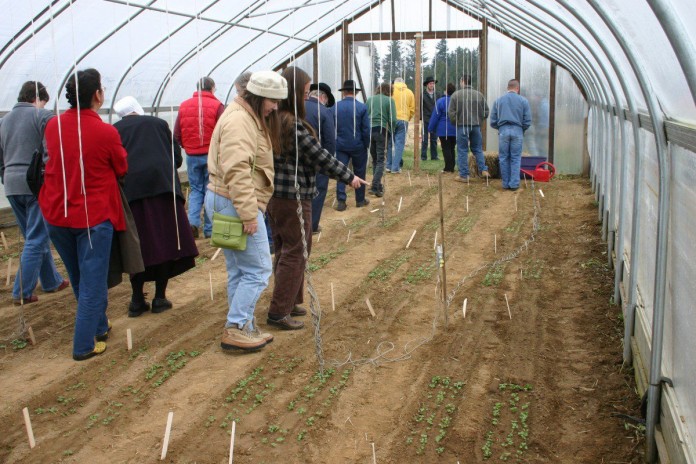By ANDY WAGNER
Despite the cold winter, spring is finally upon us. And farmers have started planting cool season specialty crops.
In the past couple decades, consumers have pushed for earlier production of fruits and vegetables. Early in the summer customers are hungry for fresh local produce and are willing to pay premium prices to get them early.
This concept of early crops and extended season is what has driven the demand for the new high tunnel frenzy. High tunnels make it possible to grow crops in cooler conditions and extend the growing season.
Not new
High tunnels are no new concept whatsoever; but are growing rapidly in popularity due to buy local and sustainable agriculture trends.
Farmers are using these high tunnels for a number of crops from strawberries and tomatoes to lettuce and other greens; some are even growing cool season crops like spinach year round.
Today, farmers have the opportunity to get an incentive payment on the high tunnel structure through the Environmental Quality Incentive Program (EQIP) with Natural Resource Conservation Service (NRCS).
This opportunity gives producers a chance to expand and improve their operations. As well as give small landowners the chance to become producers and better utilize their land for profit.
They can also be more environmentally friendly with reduced erosion and better water management from micro- irrigation.
Many producers with high tunnels have already planted cool season crops and are preparing for planting warm season crops such as tomatoes.
If you don’t have a high tunnel, however this is a perfect time to start planning for next year. If you are interested in getting cost share through NRCS you can go to your local USDA service center and fill out an EQIP application.
Stop and think
More importantly you need to stop and think, do I or will I have an outlet for the crops that I produce? What environmental limitations do I have?
Planning is key to knowing your supply and demand and as the potential producer you need to do your homework and decide how big can I build my high tunnel, what will I plant, how much of each crop will be planted, how much produce will this yield, and what time of the year can I expect for these crops to start producing?
Just as important as selling the product, you will need to know what specialty equipment will be needed for this operation, how you will manage if you are at work during the day when it gets too hot, what are your plans to open the sides, will you have someone who can check temperatures and open and close sides when needed? Or will you need to set up an electronic system on a thermostat.
These are just a few ideas of things that need to be looked into and are very important in planning to use a high tunnel for production.
Planning is important
The most important part is planning and the best advice I or anyone else can give you is to track down experienced high tunnel users and find out what they are doing, what problems they have faced and how they solved the problems, and see what they think will work and what might not.
Remember that high tunnels, when used properly, are a great way to utilize your land and make some money off your soil.
They have some great management advantages such as less pest problems, possibilities of marketing your product could be easier than bare soil later in the season crops when the market is filled up, and it is easier to control soil erosion problems.
On the other hand, high tunnels can take more management skills on things such as controlling temperatures, irrigation rates and the use of more specialized and smaller equipment are necessary. The SWCD can help with planning and research.
(Andy Wagner is Stark SWCD’s Ag/Natural Resource Specialist. )













